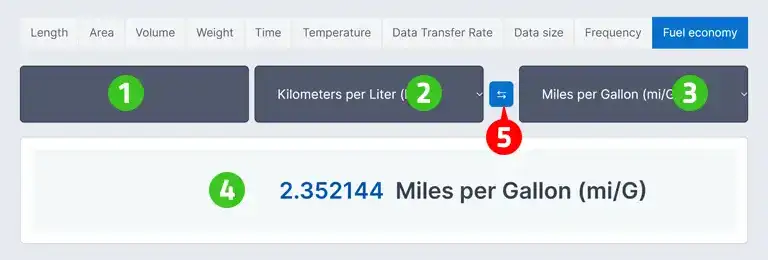Table Of Contents
Introduction to Fuel Economy Unit Converter
The Fuel Economy Unit Converter is an online tool that allows you to easily and accurately convert between various fuel economy units. It covers all major fuel economy units, from miles per gallon (mpg) to liters per 100 kilometers (L/100km). With this tool, you can instantly calculate and convert between miles per gallon (mpg), miles per Imperial gallon (mpg UK), kilometers per liter (km/L), and liters per 100 kilometers (L/100km) using precise fuel economy conversion formulas.
Explanation of Fuel Economy Units
Miles per Gallon (mpg): This is the primary fuel economy unit used in the United States. It represents the number of miles a vehicle can travel on one gallon of fuel.
Miles per Imperial Gallon (mpg UK): This unit is used in the United Kingdom. It represents the number of miles a vehicle can travel on one Imperial gallon of fuel.
Kilometers per Liter (km/L): This is the fuel economy unit used in most countries. It indicates the number of kilometers a vehicle can travel on one liter of fuel.
Liters per 100 Kilometers (L/100km): This unit is commonly used in Europe and many other countries. It represents the amount of fuel in liters required to travel 100 kilometers.
Fuel Economy Unit Conversion Formulas and Calculation Examples
How to Use the Fuel Economy Unit Converter
When you first open the page, you’ll see that the default unit is set to 1 kilometer per liter (km/L), with values for all units displayed. If you need to convert to other units, follow these steps:
- Enter the fuel economy value you want to convert in the input field.
- Select the input fuel economy unit (mpg, mpg UK, km/L, L/100km).
- Choose the target fuel economy unit you want to convert to.
- The converted result will be displayed instantly.
- Use the unit swap button to easily switch between input and output units.
FAQ
How do I use the Fuel Economy Unit Converter?
It’s very simple. Enter the fuel economy value you want to convert, select the “base unit” and the “result unit” you want to change to. The calculation is automatic without clicking any buttons. The result is displayed immediately below.
What units does it support?
Our site can convert between “miles per gallon (mpg), miles per Imperial gallon (mpg UK), kilometers per liter (km/L), and liters per 100 kilometers (L/100km)” fuel economy units.
Are there any usage restrictions?
The Fuel Economy Unit Converter on this page is provided free of charge and can be used without any restrictions.
Can I use it on mobile devices?
Yes, our fuel economy converter is optimized for mobile devices, so you can use it on smartphones or tablets just like on a PC. You can convert fuel economy units quickly and easily anytime, anywhere.
Can I trust the conversion results?
Yes, you can use it with confidence. Our converter uses international standard units and accurate conversion formulas to calculate results. You can get reliable results for practical purposes.
Where is this Fuel Economy Unit Converter useful?
This tool can be useful in the automotive industry or fields dealing with fuel efficiency. It will be especially helpful for automotive engineers, energy efficiency experts, or consumers who want to compare fuel economy standards from different countries.
How are decimal places handled in the conversions?
To show you the most accurate value possible, we calculate very precisely internally. We usually show up to 6 decimal places. If needed, you can round it to as many decimal places as you want.



